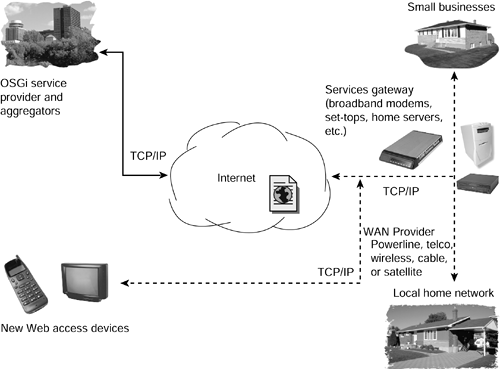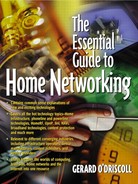OSGI ARCHITECTURE
OSGi is creating a new technical specification that is based on open standards and includes mechanisms for downloading of software from service providers, managing in- home application development cycles, security, remote management, and access to devices that are attached to the residential gateway.
To understand a complete end-to-end OSGi architecture model, you first need to be familiar with the model's main components:
Services gateway
Service provider
Service aggregator
Gateway operator
Wide area network (WAN) and carrier/ISP
Local devices and networks
The relationships between these entities are shown diagrammatically in Figure 17.1.
Services Gateway
The central component of the OSGi end-to-end architecture is the open services gateway (OSG). Service gateways further the concept of Web-enabled homes and facilitate the development and deployment of a wide range of advanced broadband-based services. From a technical perspective, the services gateway is an embedded server that is attached to a broadband Internet connection. It is highly secure and is based on a zero-local-administration management model.
The OSGi specification includes APIs for service cradle-to-grave life-cycle management, interservice dependency management, data management, device access and management, client access, resource management, and security.
Service Provider
Service providers enable the provision of services to their customer base using the services gateway in conjunction with an optional remote server and possibly some in-home client appliances. Services made available to customers are software applications that have been downloaded into the home or residential gateway. Examples of in-home services include:
Verifying that all appliances on a home integrated network are in working order
Provisioning of health care and remote monitoring services
Itemized billing of Pay-Per-View events
Figure 17.1. OSGi architectural overview

Using the Web infrastructure to remotely monitor and manage the in-home security alarm system
The aforementioned range of services will only become a true reality when consumers are comfortable with secure download facilities that only allow trusted source code to be installed on their residential gateways.
Service Aggregator
Service aggregators bundle and provision a set of home networking services for their customer base. Additionally, aggregators are responsible for ensuring that delivered services are mutually compatible and do not conflict with devices that reside on the customer's home integrated network.
Gateway Operator
In the context of an end-to-end OSGi system, the terms service aggregator and gateway operator are often used interchangeably, though strictly speaking the roles are different.
The gateway operator manages and maintains the services gateway and its services. This management responsibility may overlap somewhat with that of the service aggregator and is the reason the terms are often used interchangeably.
Typical functions of a gateway operator include:
Remotely managing the gateway and monitoring its status
Initiating, downloading, starting, stopping, updating, and removing home networking services
Controlling software and driver upgrade versions
Ensuring that communication channels between the gateway and the service providers are secure from external attacks
Controlling and managing the logical attachment of devices and local networks to the gateway, including authorizing the download of device and network drivers
Gateway operators may also generate revenue streams from the following business models:
Renting a residential gateway to consumers
Online reselling gateway appliances
Providing professional installation services to consumers
Entering into hardware maintenance contracts with home networking users
WAN Provider
The WAN provides the necessary communications between the service gateway, gateway operator, service aggregator, and service provider. This service is currently being used to offer speedy access to online information, entertainment, and e-commerce centric applications. Cable and satellite companies, ISPs, and wireless operators are examples of WAN providers who are looking at different ways of integrating their delivery mechanisms with home networking technologies. OSGi makes a clear distinction between WAN providers and gateway operators. Even though a clear distinction has been made between both parties, there will be instances of WAN providers also performing the role of gateway operators, such as the cable TV industry.
Local Networks and Devices
The last major piece of the OSGi architecture is the local home area network and household devices (i.e., Internet-ready PDAs, Internet TV sets, smart phones, and other information appliances) attached to the services gateway. Devices can be directly networked to the gateway using hardware links such as parallel or serial connections or indirectly connected by means of a local transport network, such as Bluetooth, IEEE 1394, HomePNA, powerline, or HomeRF.
